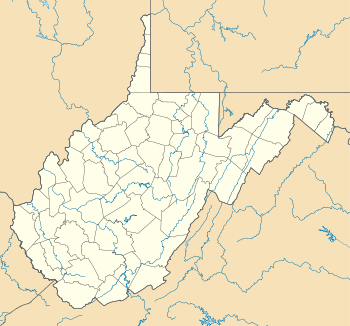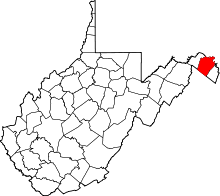Falling Waters, West Virginia
| Falling Waters | |
|---|---|
| Census-designated place (CDP) | |
 Location in Berkeley County and the state of West Virginia. | |
 Falling Waters Location within the state of West Virginia | |
| Coordinates: 39°33′33″N 77°53′27″W / 39.55917°N 77.89083°WCoordinates: 39°33′33″N 77°53′27″W / 39.55917°N 77.89083°W | |
| Country | United States |
| State | West Virginia |
| County | Berkeley |
| Area[1] | |
| • Total | 1.245 sq mi (3.22 km2) |
| • Land | 1.245 sq mi (3.22 km2) |
| • Water | 0 sq mi (0 km2) |
| Population (2010)[2] | |
| • Total | 876 |
| • Density | 700/sq mi (270/km2) |
| Time zone | Eastern (EST) (UTC-5) |
| • Summer (DST) | EDT (UTC-4) |
| ZIP codes | 25419 |
| Area code(s) | 304 |
Falling Waters is a census-designated place (CDP) on the Potomac River in Berkeley County, West Virginia. It is located along Williamsport Pike (US 11) north of Martinsburg. According to the 2010 census, Falling Waters has a population of 876.[2]
History
The community of Falling Waters was established in 1815. Because of its location between Hagerstown and Martinsburg on the Potomac River, Falling Waters is a predominantly residential community with numerous historic residences, some of which are listed on the National Register of Historic Places. However, recently the community has had a boom in new residential construction as many people use Falling Waters as a bedroom community to commute to cities nearby and as far as Washington, D.C. and Baltimore.
Falling Waters was the site of two battles during the American Civil War:
- The Battle of Hoke's Run — July 1861
- The Battle of Williamsport — July 1863 during the Gettysburg Campaign
In the latter engagement on the Maryland side of the river, Confederate general J. Johnston Pettigrew, a key leader of Pickett's Charge, was mortally wounded by Union cavalry under George Armstrong Custer. However, his men helped delay the Union forces long enough for the bulk of the Army of Northern Virginia to escape into West Virginia and then on to Virginia following its defeat at the Battle of Gettysburg.
An 1887 Scientific American article claimed that the first railroad in the United States was built in Falling Waters in 1814.
Historic sites
- Edward Colston House, 1598 Tice Road
- Harmony Cemetery, Nestle Quarry Road
- Maidstone-on-the-Potomac, 12 Temple Drive
References
- ↑ "US Gazetteer files: 2010, 2000, and 1990". United States Census Bureau. 2011-02-12. Retrieved 2011-04-23.
- 1 2 "American FactFinder". United States Census Bureau. Retrieved 2011-05-14.
